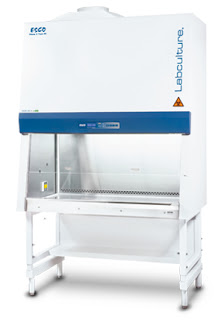 |
| One of several variants of biological safety cabinet Courtesy Esco |
Arguably, the heart of the BSC is a set of filters that efficiently trap and hold particles in the recirculating and exhaust air streams. These filters keep airborne pathogens out of the work zone, but contained within the cabinet. Some manufacturers utilize HEPA filters, while others employ the higher efficiency ULPA filters.
HEPA filters are rated and tested in accordance with accepted standards to deliver efficiency levels of 99.97% when challenged with a test aerosol containing 0.3 micron diameter particles. HEPA filters are essentially depth filters, composed of a dense array of microfibers capable of trapping or preventing passage of very small particles. ULPA filters utilize a similar microfiber media that provides a performance level of 99.999% efficiency on particles of 0.1 microns. The higher efficiency and lower contained particle size for ULPA filters is considered and advantage by some.
Biological safety cabinets and their filters, regardless of type, both have very specific standard testing procedures for finished product to assure proper safety performance. Proper handling and installation of the equipment is necessary to avoid even minor invisible damage that could impact equipment performance. In place testing of newly installed or relocated biological safety cabinets is good practice, required in many cases.
Determination of the right type or class of safety cabinet for specific applications is the role of qualified safety specialists. Once the proper type of biological safety cabinet is established for a lab, choosing a specific manufacturer and model that provides the operational features and work space that best suits the user can be facilitated by consulting with a laboratory equipment specialist. The combination of user experience and laboratory process knowledge, with the product application expertise of a specialist, will yield an effective solution.
No comments :
Post a Comment